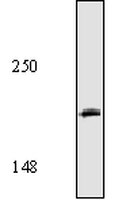NB20 Sigma-AldrichAnti-AnkyrinG Mouse mAb (463)
Anti-Ankyrin G, mouse monoclonal, clone 463, recognizes the ~190 kDa ankyrin G protein in brain extracts. It is validated for Western blotting, immunofluorescence, and frozen sections.
More>> Anti-Ankyrin G, mouse monoclonal, clone 463, recognizes the ~190 kDa ankyrin G protein in brain extracts. It is validated for Western blotting, immunofluorescence, and frozen sections. Less<<Produits recommandés
Aperçu
| Replacement Information |
|---|
Tableau de caractéristiques principal
| Species Reactivity | Host | Antibody Type |
|---|---|---|
| Ca, H, M, R | M | Monoclonal Antibody |
Prix & Disponibilité
| Référence | Disponibilité | Conditionnement | Qté | Prix | Quantité | |
|---|---|---|---|---|---|---|
| NB20-100UG |
|
Ampoule plast. | 100 μg |
|
— |
| Description | |
|---|---|
| Overview | Recognizes the ~190 kDa ankyrinG protein in brain extracts. Reacts with all spliced forms of ankyrinG.
|
| Catalogue Number | NB20 |
| Brand Family | Calbiochem® |
| Application Data |  Detection of mouse AnkyrinG by immunoblotting. Sample: Whole tissue extract from mouse brain. Primary antibody: Anti-AnkyrinG Mouse mAb (463) (Cat. No. NB20) (2 µg/ml) Detection: chemiluminescence. |
| Product Information | |
|---|---|
| Form | Liquid |
| Formulation | In 50 mM sodium phosphate buffer, 0.2% gelatin, pH 7.5. |
| Positive control | Mouse or rat brain extract or unmyelinated axons |
| Preservative | ≤0.1% sodium azide |
| Quality Level | MQ100 |
| Physicochemical Information |
|---|
| Dimensions |
|---|
| Materials Information |
|---|
| Toxicological Information |
|---|
| Safety Information according to GHS |
|---|
| Safety Information |
|---|
| Product Usage Statements |
|---|
| Storage and Shipping Information | |
|---|---|
| Ship Code | Blue Ice Only |
| Toxicity | Standard Handling |
| Storage | +2°C to +8°C |
| Do not freeze | Yes |
| Packaging Information |
|---|
| Transport Information |
|---|
| Supplemental Information |
|---|
| Specifications |
|---|
| Global Trade Item Number | |
|---|---|
| Référence | GTIN |
| NB20-100UG | 04055977209808 |
Documentation
Anti-AnkyrinG Mouse mAb (463) FDS
| Titre |
|---|
Anti-AnkyrinG Mouse mAb (463) Certificats d'analyse
| Titre | Numéro de lot |
|---|---|
| NB20 |
Références bibliographiques
| Aperçu de la référence bibliographique |
|---|
| Davis, J.Q., et al. 1995. Mol. Biol. Cell 6, 177a, supplement. Kunimoto, M., et al. 1995. FEBS Lett. 357, 217. Lambert, S., et al. 1995. Mol. Biol. Cell 6, 98a supplement. Bennett, V. and Gilligan, D.M. 1993. Ann. Rev. Cell Biol. 9, 27. Kunimoto, M., et al. 1991. J. Cell Biol. 115, 1319. Otto, E., et al. 1991. J. Cell Biol. 114, 241. Davis, J., and Bennett, V. 1984. J. Biol. Chem. 259, 13550. |







